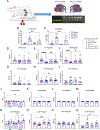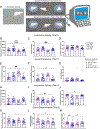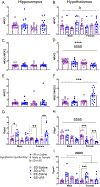Environmental influences on placental programming and offspring outcomes following maternal immune activation
- PMID: 31493445
- PMCID: PMC6906258
- DOI: 10.1016/j.bbi.2019.08.192
Environmental influences on placental programming and offspring outcomes following maternal immune activation
Abstract
Adverse experiences during pregnancy induce placental programming, affecting the fetus and its developmental trajectory. However, the influence of 'positive' maternal experiences on the placenta and fetus remain unclear. In animal models of early life stress, environmental enrichment (EE) has ameliorated and even prevented associated impairments in brain and behavior. Here, using a maternal immune activation (MIA) model in rats, we test whether EE attenuates maternal, placental and/or fetal responses to an inflammatory challenge, thereby offering a mechanism by which fetal programming may be prevented. Moreover, we evaluate life-long EE exposure on offspring development and examine a constellation of genes and epigenetic writers that may protect against MIA challenges. In our model, maternal plasma corticosterone and interleukin-1β were elevated 3 h after MIA, validating the maternal inflammatory response. Evidence for developmental programming was demonstrated by a simultaneous decrease in the placental enzymes Hsd11b2 and Hsd11b2/Hsd11b1, suggesting disturbances in glucocorticoid metabolism. Reductions of Hsd11b2 in response to challenge is thought to result in excess glucocorticoid exposure to the fetus and altered glucocorticoid receptor expression, increasing susceptibility to behavioral impairments later in life. The placental, but not maternal, glucocorticoid implications of MIA were attenuated by EE. There were also sustained changes in epigenetic writers in both placenta and fetal brain as a consequence of environmental experience and sex. Following MIA, both male and female juvenile animals were impaired in social discrimination ability. Life-long EE mitigated these impairments, in addition to the sex specific MIA associated disruptions in central Fkbp5 and Oprm1. These data provide the first evidence that EE protects placental functioning during stressor exposure, underscoring the importance of addressing maternal health and well-being throughout pregnancy. Future work must evaluate critical periods of EE use to determine if postnatal EE experience is necessary, or if prenatal exposure alone is sufficient to confer protection.
Keywords: 11-β hydroxysteroid dehydrogenase; Corticotropin releasing hormone; Early life stress; Environmental enrichment; Fkpb5; Glucocorticoid receptor; Intervention; Maternal health; Maternal immune activation; Neurodevelopment; Opioid; Placenta; Programming; Stress.
Copyright © 2019 Elsevier Inc. All rights reserved.
Conflict of interest statement
Disclosures and Potential Conflict of Interests: None.
Figures





Similar articles
-
Sex-specific regulation of stress-induced fetal glucocorticoid surge by the mouse placenta.Am J Physiol Endocrinol Metab. 2019 Jul 1;317(1):E109-E120. doi: 10.1152/ajpendo.00551.2018. Epub 2019 Apr 16. Am J Physiol Endocrinol Metab. 2019. PMID: 30990748
-
Maternal glucocorticoids do not directly mediate the effects of maternal social stress on the fetus.J Endocrinol. 2022 Nov 14;255(3):143-158. doi: 10.1530/JOE-22-0226. Print 2022 Dec 1. J Endocrinol. 2022. PMID: 36256689 Free PMC article.
-
Glucocorticoid excess and the developmental origins of disease: two decades of testing the hypothesis--2012 Curt Richter Award Winner.Psychoneuroendocrinology. 2013 Jan;38(1):1-11. doi: 10.1016/j.psyneuen.2012.08.012. Epub 2012 Sep 19. Psychoneuroendocrinology. 2013. PMID: 22998948 Review.
-
Epigenetic regulation of the placental HSD11B2 barrier and its role as a critical regulator of fetal development.Epigenetics. 2014 Jun;9(6):816-22. doi: 10.4161/epi.28703. Epub 2014 Apr 9. Epigenetics. 2014. PMID: 24717516 Free PMC article. Review.
-
Impact of maternal immune activation and sex on placental and fetal brain cytokine and gene expression profiles in a preclinical model of neurodevelopmental disorders.J Neuroinflammation. 2024 May 7;21(1):118. doi: 10.1186/s12974-024-03106-7. J Neuroinflammation. 2024. PMID: 38715090 Free PMC article.
Cited by
-
Therapeutic efficacy of environmental enrichment on behavioral, endocrine, and synaptic alterations in an animal model of maternal immune activation.Brain Behav Immun Health. 2020 Mar;3:100043. doi: 10.1016/j.bbih.2020.100043. Epub 2020 Jan 30. Brain Behav Immun Health. 2020. PMID: 32368757 Free PMC article.
-
Investigating milk-derived extracellular vesicles as mediators of maternal stress and environmental intervention.bioRxiv [Preprint]. 2025 Jun 27:2025.05.30.656911. doi: 10.1101/2025.05.30.656911. bioRxiv. 2025. PMID: 40502175 Free PMC article. Preprint.
-
Placental and cord serum inflammatory cytokines and children's domain-specific neurodevelopment at 18 months: effect modification by maternal vitamin D status.BMC Med. 2025 Apr 30;23(1):252. doi: 10.1186/s12916-025-04096-w. BMC Med. 2025. PMID: 40307787 Free PMC article.
-
Translational opportunities in the prenatal immune environment: Promises and limitations of the maternal immune activation model.Neurobiol Dis. 2020 Jul;141:104864. doi: 10.1016/j.nbd.2020.104864. Epub 2020 Apr 9. Neurobiol Dis. 2020. PMID: 32278881 Free PMC article. Review.
-
Peripubertal antagonism of corticotropin-releasing factor receptor 1 results in sustained changes in behavioral plasticity and the transcriptomic profile of the amygdala.bioRxiv [Preprint]. 2025 Jan 4:2024.08.14.607957. doi: 10.1101/2024.08.14.607957. bioRxiv. 2025. Update in: Neuroscience. 2025 Feb 16;567:261-270. doi: 10.1016/j.neuroscience.2025.01.007. PMID: 39185241 Free PMC article. Updated. Preprint.
References
-
- Andersen SL (2003). Trajectories of brain development: point of vulnerability or window of opportunity? Neurosci Biobehav Rev, 27, 3–18. - PubMed
-
- Asiaei M, Solati J, Salari A-A (2011). Prenatal exposure to LPS leads to long-lasting physiological consequences in male offspring. Developmental Psychobiology, 53, 828–838. - PubMed
-
- Binder EB (2009). The role of FKBP5, a co-chaperone of the glucocorticoid receptor in the pathogenesis and therapy of affective and anxiety disorders. Psychoneuroendocrinology, 34S, S186–S195. - PubMed
Publication types
MeSH terms
Substances
Grants and funding
LinkOut - more resources
Full Text Sources
Medical
Miscellaneous

